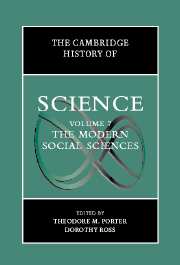Book contents
- Frontmatter
- 1 Introduction: Writing the History of Social Science
- PART I SCIENCES OF THE SOCIAL TO THE LATE NINETEENTH CENTURY
- PART II THE DISCIPLINES IN WESTERN EUROPE AND NORTH AMERICA SINCE ABOUT 1880
- PART III THE INTERNATIONALIZATION OF THE SOCIAL SCIENCES
- PART IV SOCIAL SCIENCE AS DISCOURSE AND PRACTICE IN PUBLIC AND PRIVATE LIFE
- 30 The Uses of the Social Sciences
- 31 Managing the Economy
- 32 Management and Accounting
- 33 Polling in Politics and Industry
- 34 Social Science and Social Planning During the Twentieth Century
- 35 Social Welfare
- 36 Education
- 37 The Culture of Intelligence
- 38 Psychologism and the Child
- 39 Psychiatry
- 40 Gender
- 41 Race and The Social Sciences
- 42 Cultural Relativism
- 43 Modernization
- Index
- References
40 - Gender
from PART IV - SOCIAL SCIENCE AS DISCOURSE AND PRACTICE IN PUBLIC AND PRIVATE LIFE
Published online by Cambridge University Press: 28 March 2008
- Frontmatter
- 1 Introduction: Writing the History of Social Science
- PART I SCIENCES OF THE SOCIAL TO THE LATE NINETEENTH CENTURY
- PART II THE DISCIPLINES IN WESTERN EUROPE AND NORTH AMERICA SINCE ABOUT 1880
- PART III THE INTERNATIONALIZATION OF THE SOCIAL SCIENCES
- PART IV SOCIAL SCIENCE AS DISCOURSE AND PRACTICE IN PUBLIC AND PRIVATE LIFE
- 30 The Uses of the Social Sciences
- 31 Managing the Economy
- 32 Management and Accounting
- 33 Polling in Politics and Industry
- 34 Social Science and Social Planning During the Twentieth Century
- 35 Social Welfare
- 36 Education
- 37 The Culture of Intelligence
- 38 Psychologism and the Child
- 39 Psychiatry
- 40 Gender
- 41 Race and The Social Sciences
- 42 Cultural Relativism
- 43 Modernization
- Index
- References
Summary
As a social scientific term, gender came into common use only in the final quarter of the twentieth century. But its core idea, that biological sex and its cultural expression are separable, had been evolving for over a hundred years. As rapid urbanization fostered greater sexual freedom and spurred a vibrant women’s movement at the end of the nineteenth century, a disparate group of sex reformers, feminists, and university-trained researchers began to question a number of conventional beliefs. Does effeminacy in men signal biological abnormality? Is politics, by nature, a masculine enterprise? Are geniuses disproportionately male? Do females lack sexual drive? At the turn of the century, most social theorists answered yes to these questions. But by the 1970s, even as researchers were mapping the human brain with ever-greater precision, scholars had ceased treating the cultural expression of sex as a direct product of physiology. Symbolic of this dramatic shift, social scientists abandoned “sex” in favor of “gender” when discussing human behavior. Long used exclusively as a grammatical category, “gender” appealed to those who found the biological associations of “sex” too limiting. Here was a term that freed investigators to explore with new intensity the multiple ways in which cultures distinguish males from females, structure sexual experience, and deploy power.
- Type
- Chapter
- Information
- The Cambridge History of Science , pp. 678 - 692Publisher: Cambridge University PressPrint publication year: 2003
References
- 1
- Cited by

